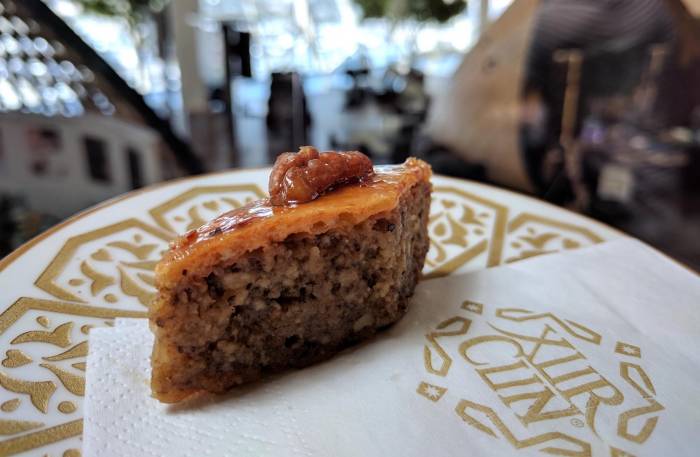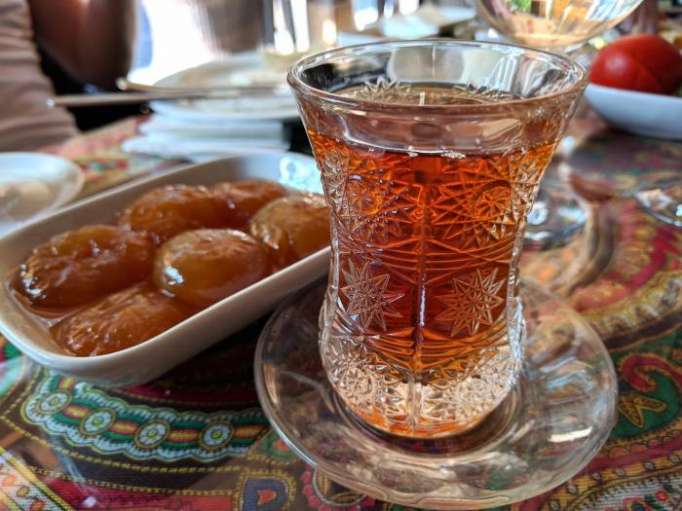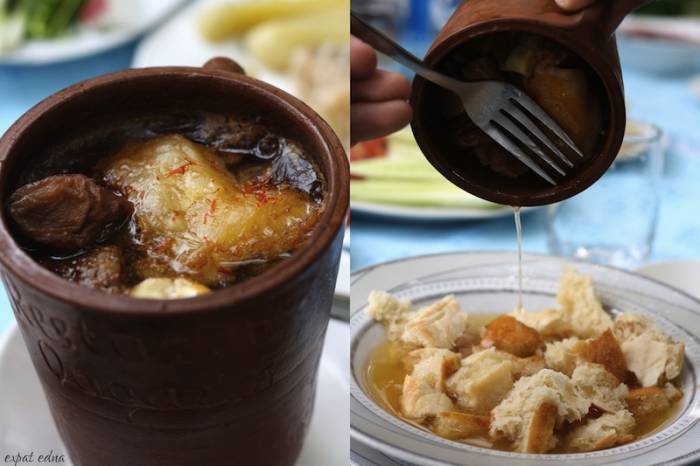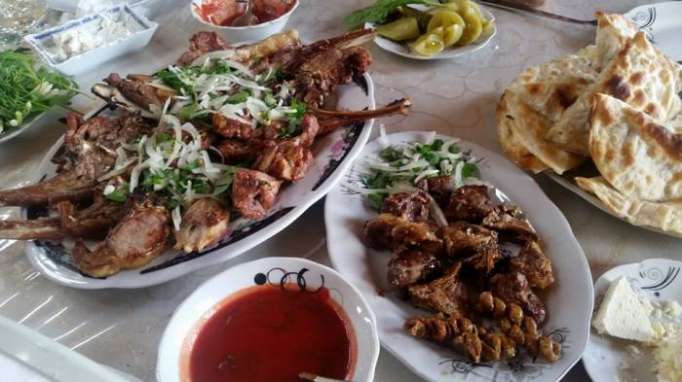As a result, the best Azerbaijan foods are those which show more than one type of cuisine and are true examples of fusion recipes. But unlike the foodie trend, Azerbaijan food is not a modern day interpretation of the centuries old traditions but rather a homage to the caravans that threaded the Silk Route and brought goods and produce from Africa to the Far East. When you sit down at a restaurant and decide what to eat in Azerbaijan, you will be taking a bite out of that history.
I believe food tells a lot about a culture so on my travels I always make sure to try as many dishes as possible. The food of Azerbaijan talks to the agricultural past of the country and to the fertile climatic zones outside of Baku which allows the country to grow a variety of grains, vegetables, fruits, nuts and to raise a number of different animals. It is also some of the best I have tasted so I made the most of every meal and ate at all the best restaurants in Baku and the rest of the country. This is a selection of the dishes you can’t miss when you visit Azerbaijan and some of the best restaurants to try them.
Best Azerbaijan Food – What to eat in Azerbaijan
Some of the most typical Azeri dishes like kebab or tea can also be found elsewhere but in Azerbaijan they seemed to taste better. Do not leave the country without trying some of the following dishes.
Plov or pilaf

Pilaf, or rice, is one of the most typical Azeri dishes. It resembles Indian Biryani or Moroccan spiced rice which often comes with dried fruits and nuts. And this is precisely the best part of Azeri pilaf, the touches of spices and dried fruits which give it an exotic and sweetish flavor. Expect to enjoy it with saffron and cinnamon plus lots of dried fruits like apricot or even dates and chestnuts. Rice will usually be served with meat, most commonly mutton or lamb which are the favourite combinations. You can also get chicken with it. The most revered of the rice dishes is Shakh Plov or King Pilaf which is a very unique recipe where the rice is encased in a round crust made with layers of crispy lavash, the thin tortilla style bread that usually accompanies the kebabs. When served, the cake is cut into four pieces so the rice inside is revealed to the guests in what is quite a spectacle.
Kebab

Pilaf, or rice, is one of the most typical Azeri dishes. It resembles Indian Biryani or Moroccan spiced rice which often comes with dried fruits and nuts. And this is precisely the best part of Azeri pilaf, the touches of spices and dried fruits which give it an exotic and sweetish flavor. Expect to enjoy it with saffron and cinnamon plus lots of dried fruits like apricot or even dates and chestnuts. Rice will usually be served with meat, most commonly mutton or lamb which are the favourite combinations. You can also get chicken with it. The most revered of the rice dishes is Shakh Plov or King Pilaf which is a very unique recipe where the rice is encased in a round crust made with layers of crispy lavash, the thin tortilla style bread that usually accompanies the kebabs. When served, the cake is cut into four pieces so the rice inside is revealed to the guests in what is quite a spectacle. The recipe was invented by a famous Azeri chef.
Qutab

A delicious sort of thick savory pancake filled with meats, cheese or vegetables like spinach along with yogurt mixed with coriander, fennel and sumac. Traditional qutab is not a simple pancake and the dough is made in a similar way to the Indian prata by combining several layers of cooked dough. They are truly delicious but also very rich as they tend to be cooked with lots of butter.
Dolma

Stuffed vegetable dolmas
Dolmas are the staple in Azerbaijan cuisine. To me, they remind me of the typical Lebanese stuffed vine leaves but in Azerbaijan they can also be made with cabbage or come in the form of stuffed vegetables like tomatoes, aubergines or peppers, so dolmas as basically “stuffed vegetables”. When they are stuffed with meat, dolmas are served warm and when they are stuffed with rice they are served cold, like in the Middle East. Originally, stuffed vegetables were enjoyed in Ancient Greece and called fyllas. Today’s word, dolma, comes from the Turkish for stuffing.

Vine leaf dolma
Dushbara

Dushbaras are some of the most delicious Azeri dishes. They are tiny little meat dumplings similar to the Nepalese, Bhutanese or Mongolian momo or the Japanese gyoza in flavour but resembling the Italian ravioli in shape. In Azerbaijan they are smaller and the dumpling dough is thicker. They are also usually served warm in a vegetable broth.
Pakhlava
Pakhlava

Pakhlava are traditionally cooked for Novruz, the Zoroastrian festival celebrated in Azerbaijan when spring arrives, but today it is available everywhere and eaten at all times. They are very similar to the Turkish baklava and are incredibly sweet and filling so they make for the best companion to strong black tea that is so commonly drunk across the country. Pakhlava are made of pastry layered with eight to ten levels of ground hazelnuts or walnuts mixed with honey or sugar and spices like cardamom or clove. The top layer is made with yolk mixed with saffron and topped with a piece of nut, either walnut or hazelnut. Pakhlava are some of the sweetest pastries you will ever find.
Badambura

Badambura is slightly less sweet than pakhlava and has no honey so it is less sticky as well. It is filled with plain ground sugar, almonds (badam in Azeri language), cardamom and vanilla so it is definitively filling too.
Ghuru Kingal
This dish is best described as a deconstructed meat dumpling that is as messy as it is delicious. It is usually made of a bottom layer of several wide strips or diamond shaped pieces of steamed dumpling pasta topped with minced lamb meat, fried onions and spices. Try it at Sahil Restaurant.
Saj
This is a meat and vegetable dish usually served in the traditional saj copper or cast-iron dish which comes to the table over a coal brazier or flame. Although it is usually made of lamb, you can find variations made of sturgeon, veal or chicken. The copper dish was the traditional cooking method and it is still used today for serving the saj in some restaurants (like Zeytun which is a great place to enjoy it). The stir fried meat is served with fried vegetable slices placed around the plate and lavash, the thin flatbread.
Typical Azeri breakfast

I had booked the Fairmont Baku Flame Towers without breakfast because I wanted to ditch the international buffet option in favour of the local foods. But it turned out to be quite hard to find places that were open on weekend mornings. We did find a few (which I listed in the restaurant sections below) and managed to enjoy the traditional Azeri breakfast very much. Being a bread lover, the Azerbaijani breakfast spread was a lovely start to the day. Locals eat tandoor-baked bread with honey, butter, cream and fresh cheese. Everything is accompanied by copious amounts of tea with jam. Although these are not exceptional ingredients or components at a breakfast table, the type and combinations are quite unique.

The bread is baked in a traditional Indian-style clay tandoor oven, like the ones I saw in Djibouti, and is not your typical naan bread but a thicker version with a doughy center and a toasted crust with a dash of sesame seeds. It is delicious. The bread is eaten with rich, churned butter, fresh thick cream, fresh sheep cheese and honey. You can put it all on a plate and dip the bread or be like me and spread it over. Vegetables like tomato and cucumber can also be served and everything is washed down with unlimited amounts of black tea that is served with a side of jammed fruit (see next). In order to choose your breakfast items, the server will come with a tray that includes them all in individually prepared small plates and you can pick the items that you prefer. Locals usually get the whole tray.
Tea with jam

Perhaps the most uniquely Azeri dish to try is the tea with jam. Tea came to Azerbaijan through the Silk Route trade with the Far East but the locals added an interesting element, a side of jammed fruit. That is, fruit that has been slowly baked with sugar as if to make jam, but has been left with pieces intact.
The tea itself is served very hot, strong, black and in small pear-shaped glasses, like in other places in the Middle East or Northern Africa like Morocco or Egypt. The shape of the glass is believed to represent the ideal shape of a woman. The tea comes with a slice of lemon and cubed sugar as well as the jammed fruit, but without milk. The tradition of the sugar cubes is thought to come from medieval times when the king used it to test if the tea was poisoned as sugar was supposed to react to it. You are not meant to eat the jam but to place the piece in your mouth and drink the tea through it, like some might do with the sugar cubes. The water for tea is boiled in metal samovar containers.
When we were there it was the season for figs so our tea was served with entire figs that had been slowly cooked in sugar. This was actually one of the best ways to drink tea as I am not a big fan of its bitterness. The jam completely masked it.
The culture of tea is so widely spread that there are plenty of tea houses across the country, they are called chaykhana. Tea houses were traditionally the space for men as women were not visible in public life. At tea houses, tea is usually served continuously and people play backgammon or smoke shisha.
You may also find that tea is served at the beginning of a meal as a welcoming gesture and to incite conversation.
Piti

This is another unique dish that I have not seen anywhere else but it is common of Tajikistan, Iran and Turkey. Piti is a mutton stew served with potatoes and chickpeas with an intense flavour and cooked inside the pots called piti in Turkish. The ingredients, especially the added fat, are probably enough to clog all your veins, but it is tasty!
What makes piti extra special is the way it is served with the broth in which it was cooked, poured into a bowl and eaten first and then the stew added on top of the plate when the broth is eaten (or when there is a bit left). Bread can be added to the broth as well. To serve it, the pot where it was all cooked is brought to the table, the broth poured onto the soup plate and then the stew mashed inside the piti. It is as delicious as it sounds and definitively rich.
Nuts

Azerbaijan produces a lot of nuts, particularly walnuts and hazelnuts. So in the summer, when they are in season, you will see them being sold everywhere, roadside, in street stalls, in shops… be sure to try them out and, if you’ve never seen them before, buy them raw, inside their shells.
Lavash Turshu

Lavash turshu has to be the weirdest item I have ever eaten. It is difficult to explain but try to imagine a sweet, salty and sour pickled fruit pancake that is left to dry in the sun. That was a mouthful but it truly is what I just said. Locals take fruit, cook it slowly with vinegar and sugar to make a sort of jam, then spread the jam into pancake shapes and leave it to dry in the sun. It is sold roadside everywhere outside of Baku and also at market stalls and their colourful appearance is hard to miss. It is not so common to find it in shops and is certainly unique. Turshu refers to vegetable pickles that are very common in the Caucasus region. Pickles in pots can be found everywhere in the country. The lavash version is this pickle-flavour type of pancake that can be made with fruits or vegetables. They are also a great way to try different fruits unique to the country. I enjoyed the fruity lavash but not the vegetable ones which I found very unpleasant. They are not for everyone, but you should definitively try.
The original article appeared on onceinalifetimejourney.com.
More about: Azerbaijan food
















































